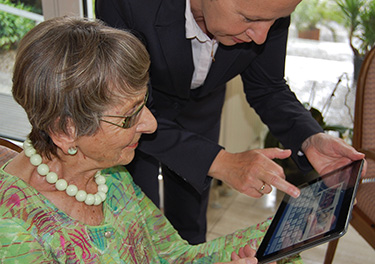|
Subscribe / Renew |
|
|
Contact Us |
|
| ► Subscribe to our Free Weekly Newsletter | |
| home | Welcome, sign in or click here to subscribe. | login |
Construction
| |
 |
July 23, 2015
It’s never too early to consider tech in your nursing home project
Sparling, a Stantec Company

Brunk
|
The collision of two societal mega-trends, technology and the aging of America, is fueling the need for developers of long-term and post-acute care facilities to invest in a full range of cutting-edge technology in their buildings.
Owners are finding that robust technology platforms improve business returns and make life better and healthier for the residents.
Broadband in demand
Modern senior living centers are influenced by a multitude of factors that are revolutionizing the way we serve our seniors in long-term care settings.
The increased demand for connectivity from seniors and their family members is a driving force toward incorporating technology in today’s centers. It has been found that broadband connectivity has a positive impact on the health, well-being and satisfaction of seniors.
Technology provides operational advantages, cost savings, efficiencies and revenue-generating possibilities that come with taking a holistic approach to business operations, resident care, quality of life and customer satisfaction. Facilities today must also meet Affordable Care Act requirements that address HIPAA compliance (referring to patient confidentiality), “meaningful use” of electronic health records, and interoperability with acute care hospital partners.
Assessing needs
In today’s hyper-competitive senior living marketplace, owners who plan to distinguish themselves are making decisions very early in their development’s design process to incorporate leading-edge infrastructure technologies as part of the construction costs, as this is the best time to consider investments that will be part of the project and property for many decades to come.
Information technology planning builds on an organization’s strategic goals and the technology applications that are relevant to each of those goals. Critical items to assess include:
• The existing or potential IT infrastructure and how it supports current operations.
• Existing or potential technology applications and future technology-related needs.
• Information technology competencies among staff and IT teams.
• The need for an IT team to update or upgrade technology applications in order to support new business models and operations, as identified in the strategic plan.
This assessment should include interoperability, integration, interfacing, meaningful use requirements and health information exchange (HIE) needs, including the HIE needs of strategic health care partners.
Making a plan
Once the assessment phase of the strategic IT plan is completed, the executive team, with the help of IT leadership, should formulate a plan to update the IT infrastructure.
That infrastructure should support all potential technology applications needed now and in the future, including applications that support staff, operations and management, as well as those that serve residents/clients. Applications serving residents/clients might include Internet access, telephone, television, social connectedness technology, concierge services, energy management and maintenance requests.
The strategic IT planning process will provide the organization with guidelines it can use to develop detailed specifications for the IT infrastructure, as well as for the selection of, and operational planning for, specific technology applications.
Network infrastructure has always played a critical yet inconspicuous role as the highway over which data flows within an organization and between organizations.
Software applications must run efficiently on this network highway using data in countless ways to give care providers the tools they need to improve the quality of care. Today’s organizational leaders must align costs, simplicity, scalability and redundancy to ensure environments can meet and exceed resident/patient safety and end-user demands.
To ensure that the technology infrastructure will support the building’s day-to-day operations and also ensure complete broadband connectivity to every resident, some of the many issues that the owners are reviewing before making final decisions include:
• What kind of hardware and software and what quantities should be provided to support operations, resident/patient care and marketing?
• What kind of hardware and clinical systems will support the care staff, including whether such devices should be wired or wireless?
• Do we need to outfit an on-site telemedicine suite with high-speed videoconferencing capabilities?
• What is needed for HIPAA-compliant software, encryption, messaging and training?
• The need for video and Web conference capabilities for the residents to communicate with friends, family and health care providers.
• The potential build-out into resident rooms, including an always-on IP-based broadband network, digital television, Internet access, phone lines, video-on-demand services, digital music and interactive gaming.
• Remote monitoring of residents in the memory care unit via Web cams and remote-monitoring medical devices.
• The creation of an interactive website that will market the facility using social media, video, virtual tours, and 360-degree photos.
Health care and aging-services organizations are driven by high service expectations more than ever before and are seeking to transform themselves by providing higher-quality care, becoming safer and more efficient, and providing better experiences for seniors, families and staff.
Successful senior living organizations are partnering with experienced architects, technology consultants and nationally known experts in senior living communities, and together are making a winning combination that is helping usher in a new type of senior living community.
Berry Brunk is the health care technology practice leader at Sparling, a Stantec Company.
Other Stories:
- Hospital addition zeroes in on better patient care
- High-tech lights can aid patients by mimicking the effects of nature
- What we’ve learned about making hospitals better for seniors
- Vacant big-box store finds new life as Children’s clinic
- New clinic at Swedish will treat patients who suffer from chronic pain
- Whidbey hospital’s hyper-efficient HVAC system may be the first of its kind here
- How a pharmacy was designed to limit exposure to toxic drugs
- The way we design health care projects is changing in a big way
- Hospice brings comfort to dying patients



